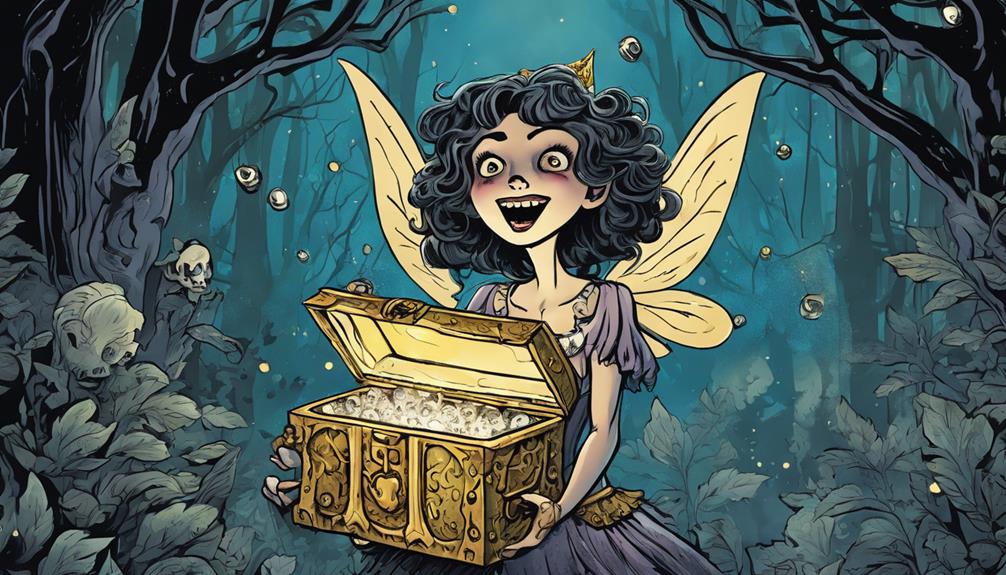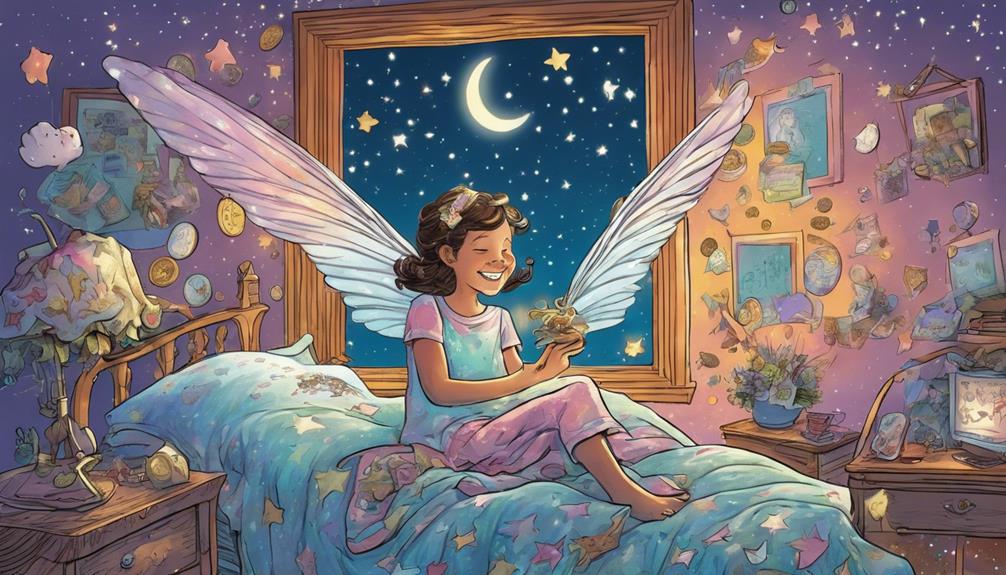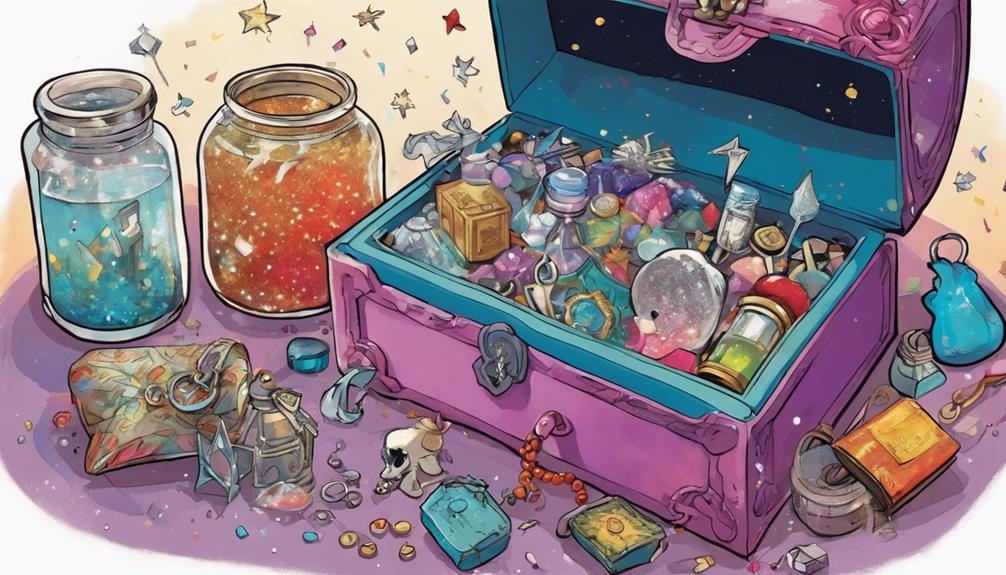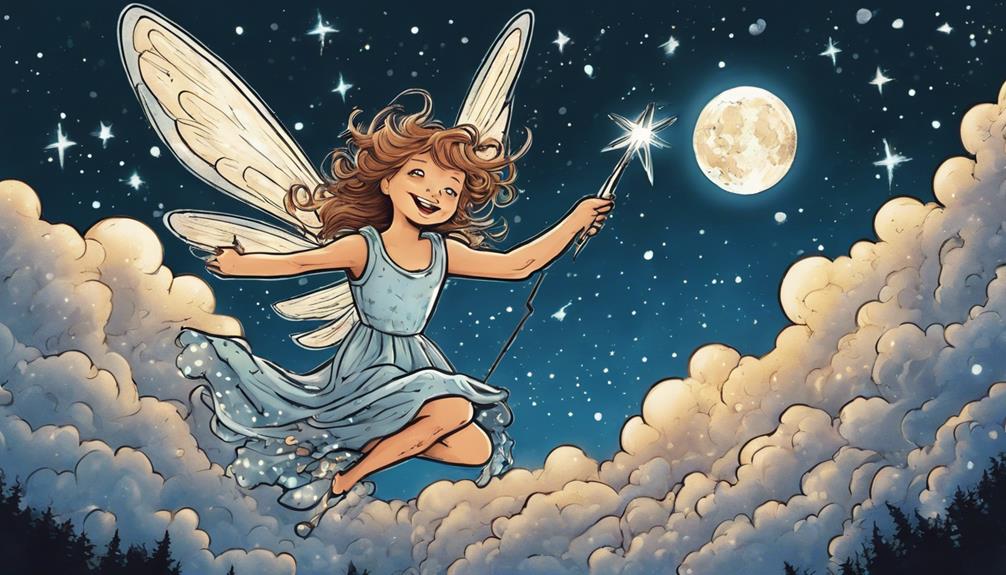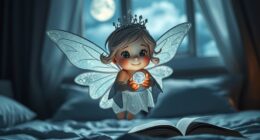The Tooth Fairy isn't just a charming legend; she's part of a bigger picture that shapes your child's understanding of growth and change. When your little one loses a tooth, it's not just about exchanging it for money. It's a chance to nurture imagination and creativity while addressing childhood fears. Each tiny tooth carries deeper meaning, symbolizing milestones and memories. Plus, those coins can teach valuable lessons about budgeting and the concept of worth. If you think you know everything about the Tooth Fairy, you might be surprised by what her true motives really are.
Key Takeaways
- The Tooth Fairy's tradition masks deeper meanings about childhood milestones, reflecting parental nostalgia and cultural values.
- Rising financial expectations for tooth payouts can lead to stress for parents, influencing children's understanding of money.
- The ritual of tooth collection fosters emotional growth, helping children cope with loss while nurturing imagination and creativity.
- Environmental awareness is shaping parental choices regarding tooth disposal, promoting eco-friendly practices in childhood traditions.
The Origins of the Tooth Fairy
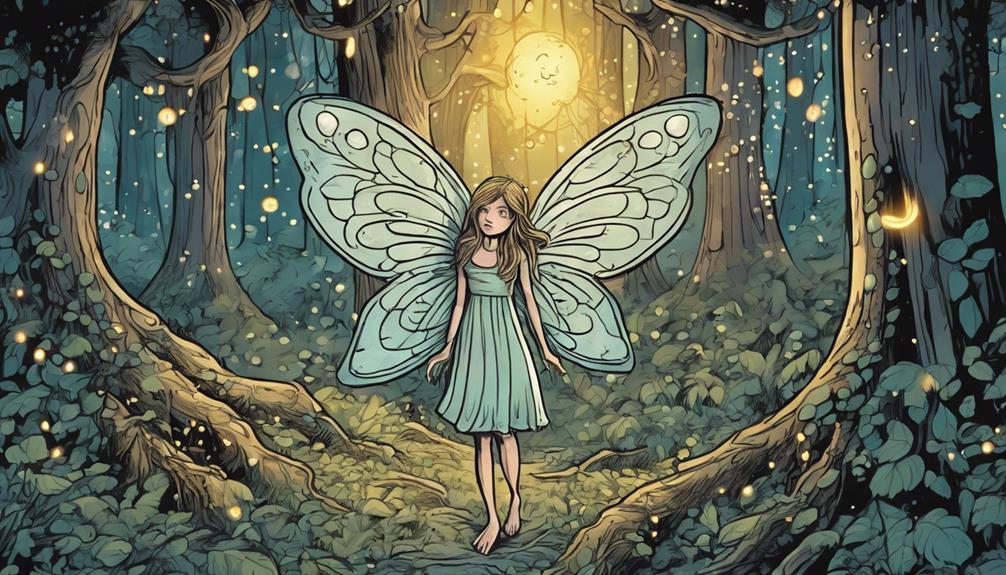
The Tooth Fairy's origins trace back to various cultures that celebrate the loss of baby teeth with rituals designed to ease children's fears and encourage their growth. In medieval Europe, parents often buried lost teeth in hopes of promoting healthy adult teeth. In some cultures, children would toss their teeth into the fire, believing that doing so would lead to stronger, more prosperous teeth.
In Scandinavian traditions, children would place their lost teeth under their pillows, expecting a reward in return. This practice likely evolved into the Tooth Fairy that we recognize today. The fairy symbolizes a comforting figure, transforming a potentially scary experience into a magical one. Many cultures also have unique variations, like the Spanish “Ratoncito Pérez,” a small mouse that collects teeth.
These rituals not only encourage children to embrace the natural process of losing teeth but also create a sense of wonder and excitement. You might find that sharing these stories with your child helps them feel more at ease during this milestone.
The Psychological Impact on Children
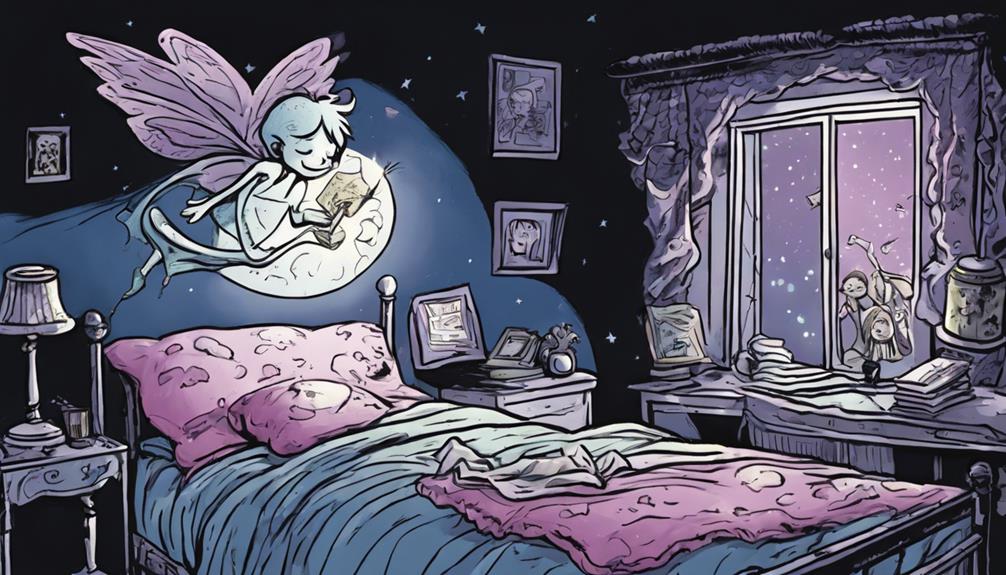
When your child believes in the Tooth Fairy, they're embracing a world of magic and wonder.
However, this belief can also stir up fears about loss and change, particularly when it comes to losing their teeth.
Understanding these psychological impacts helps you navigate their emotional landscape during this whimsical time.
Belief in Magic
Believing in magic can spark a child's imagination and foster a sense of wonder about the world around them. When you encourage your child to embrace the idea of the Tooth Fairy, you're not just playing along with a fun tradition; you're also nurturing their creativity and curiosity. This belief can lead to richer storytelling, imaginative play, and emotional development.
Here's a quick look at some of the benefits that belief in magic can bring to your child's life:
| Positive Effects | Examples |
|---|---|
| Enhanced Creativity | Creating stories or games |
| Emotional Growth | Learning to cope with loss |
| Problem Solving Skills | Imagining solutions in play |
Allowing your child to believe in the Tooth Fairy helps them explore complex ideas in a safe environment. It encourages critical thinking as they ponder the mysteries of life and the world around them. So, next time you hear, “Is the Tooth Fairy real?” remember that this belief can be a delightful part of their growth and development. Embrace it and watch their imagination flourish!
Fear of Loss
Fear of loss can deeply affect children, often manifesting in anxiety about losing cherished items or loved ones, including the magical figures like the Tooth Fairy. When you encourage your child to place their lost tooth under the pillow, you're igniting a blend of excitement and fear. They may worry about whether the Tooth Fairy will actually come, and if she does, what if she doesn't leave anything behind?
This anxiety can extend beyond teeth. Kids might begin to feel insecure about the permanence of their relationships or belongings. Every time they lose something, they could experience a heightened sense of dread, fearing an emotional void.
As a parent, it's essential to acknowledge these feelings. Validate their concerns by discussing what loss means and how it's a part of life.
Financial Implications for Parents
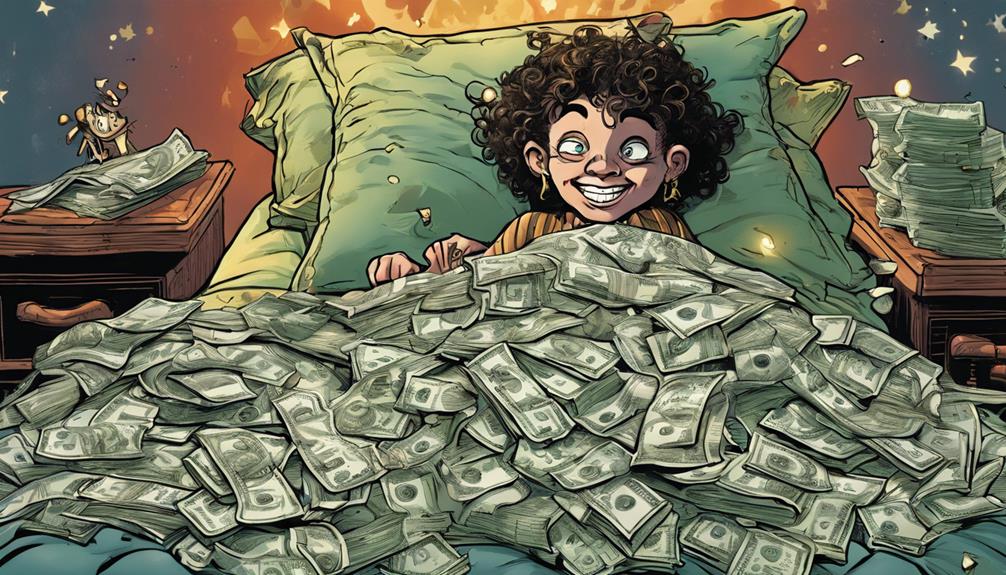
When your child loses a tooth, you probably feel the pressure of tooth value inflation as you consider how much to leave under the pillow.
Budgeting for lost teeth can quickly add up, impacting your finances in ways you mightn't expect.
Let's explore how these hidden costs affect your wallet and your planning.
Tooth Value Inflation
Tooth value inflation has parents scrambling to keep up with rising expectations for how much they should leave under the pillow. Gone are the days when a quarter or dollar would suffice; now, kids are anticipating $5, $10, or even more for each lost tooth. This trend can put a strain on your wallet, especially if you have multiple children losing teeth in close succession.
You might find yourself weighing the pros and cons of keeping up with the inflationary demands. While you want to maintain the magic of the Tooth Fairy tradition, the financial implications can be intimidating. If you're not careful, you could inadvertently set a precedent that's hard to maintain. Each child starts comparing tales of what their friends received, and that can lead to pressure for even higher payouts.
Ultimately, you'll need to reflect on your family's budget and the message you want to send about money. Tooth value inflation isn't just a fun quirk of childhood; it's also a reality check for parents trying to balance tradition with financial responsibility.
How you navigate this tricky terrain will shape your child's understanding of value and wealth in the long run.
Budgeting for Lost Teeth
Budgeting for lost teeth can feel overwhelming as you try to balance the excitement of the tradition with the reality of your family's finances. You want to make the Tooth Fairy experience magical for your child, but you also need to take into account the costs involved. It's essential to plan ahead so that the loss of a tooth doesn't catch you off guard financially.
Here's a quick breakdown of potential costs associated with each lost tooth:
| Tooth # | Average Payout | Total Cost (assuming 20 teeth) |
|---|---|---|
| 1 | $3 | $60 |
| 5 | $5 | $100 |
| 10 | $7 | $140 |
| 15 | $10 | $200 |
| 20 | $15 | $300 |
As you can see, the total cost can add up quickly, especially if your child is losing teeth at a rapid pace. Think about setting a budget for each tooth, and adjust it based on your family's financial situation. By doing this, you can guarantee that your child enjoys the magic of the Tooth Fairy without breaking the bank.
Cultural Variations of the Tradition
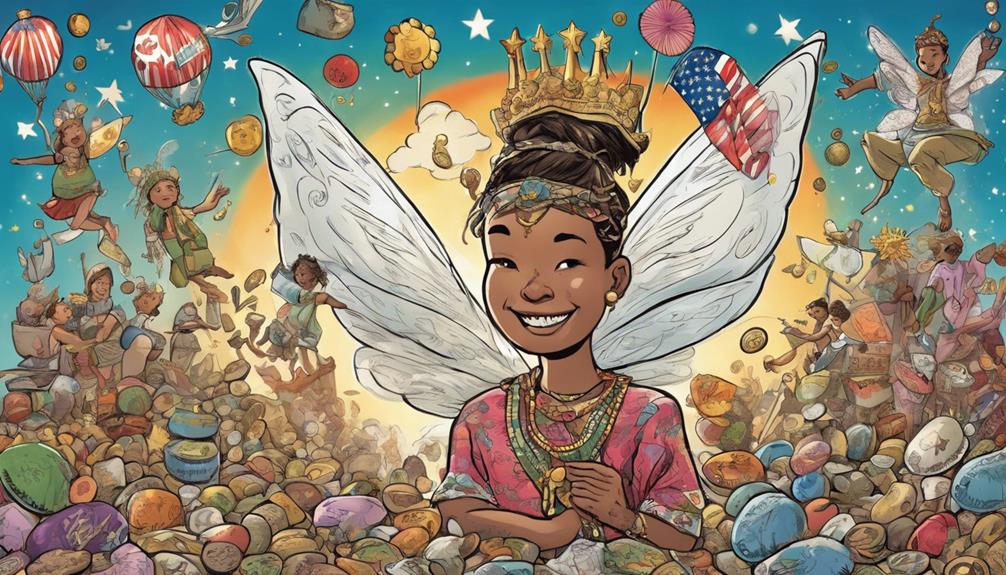
Across the globe, various cultures celebrate the loss of baby teeth with unique traditions that often reflect their values and beliefs.
In the United States, you might slip a tooth under your pillow, hoping for a visit from the Tooth Fairy. Meanwhile, in Spain and many Latin American countries, kids often await a character called Ratoncito Pérez, a little mouse who exchanges teeth for gifts.
In some Asian cultures, you'll find different customs. For instance, in India, children may throw their lost teeth onto the roof, believing that doing so will encourage new teeth to grow strong and healthy. In Japan, kids might toss their teeth into a bowl of rice, hoping for a similar outcome.
In Turkey, children often bury their teeth in the ground, symbolizing a connection to the earth and a wish for good luck.
These traditions show how different societies approach the milestone of losing teeth, emphasizing values like health, protection, and growth. Whether it's a fairy, a mouse, or a simple act of burying, each practice offers a glimpse into how cultures celebrate the journey of childhood.
Secrets Behind Tooth Collection
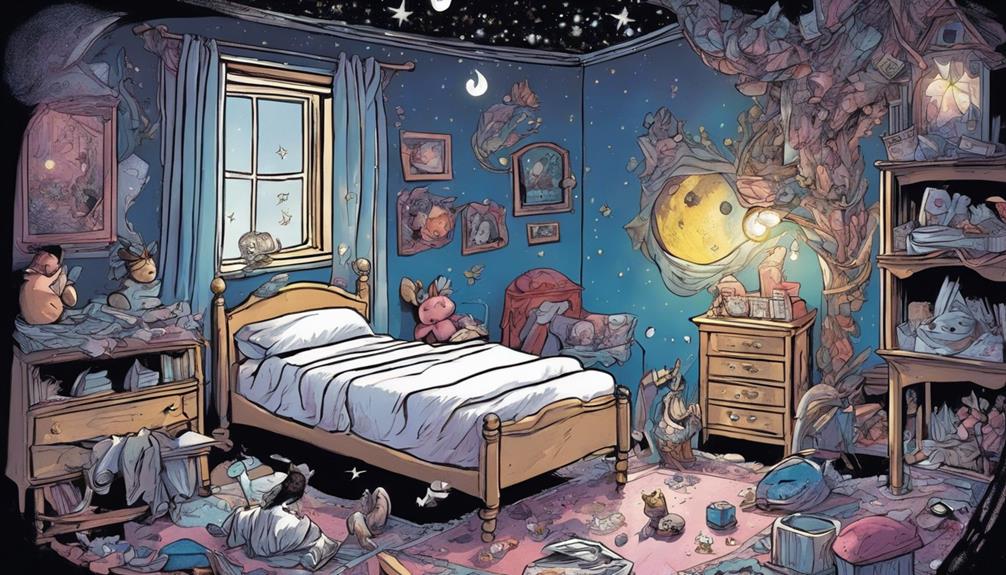
Many kids unknowingly participate in a fascinating tradition where their lost teeth become symbols of childhood milestones and, in some cases, valuable collectibles. The act of placing a tooth under the pillow often feels magical, but there's more to it than meets the eye. You mightn't realize that the Tooth Fairy's collection isn't just about monetary exchange; it's a subtle way for her to gather insights into childhood development and cultural trends.
When you lose a tooth, consider the implications of that small, white object:
- Milestones: Each tooth represents growth and evolution into a new phase of life.
- Nostalgia: Collecting teeth sparks memories for parents and can even be a keepsake for future generations.
- Cultural Insights: The types of teeth collected can reflect societal norms and beliefs about childhood.
- Economic Impact: The amounts left by the Tooth Fairy can influence children's perceptions of value and money.
The Tooth Fairy and Childhood Fear
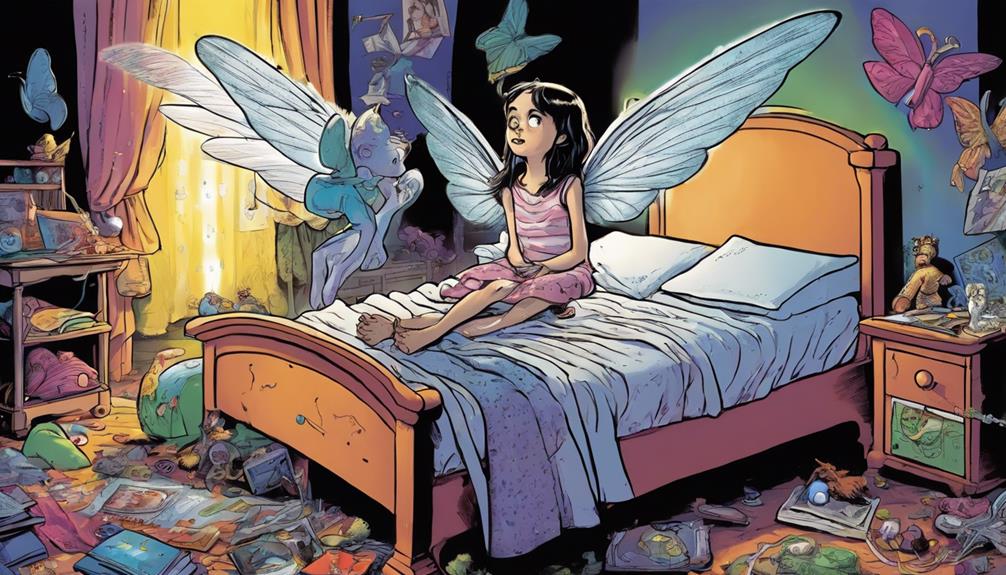
While the Tooth Fairy's whimsical charm brings excitement, it can also stir up childhood fears about losing teeth and the unknown that follows. You might find yourself anxiously wondering what happens when you lose a tooth. Is it painful? Will it hurt? These questions can create a storm of anxiety in young minds, causing sleepless nights and fears that linger.
When you place that tiny tooth under your pillow, a mix of excitement and dread often swirls within you. You anticipate the reward, but the uncertainty of what the Tooth Fairy really is can be unsettling. Is she friendly, or does she have other motives? You might even worry if your teeth are good enough to earn that shiny coin.
As you navigate this rite of passage, it's important to understand that these fears are normal. They reflect your developing understanding of loss and change. Embracing the magic while recognizing your feelings can help ease the shift. Remember, losing teeth is a natural part of growing up, and the Tooth Fairy is just a fun way to celebrate that change.
Frequently Asked Questions
Does the Tooth Fairy Have a Favorite Type of Tooth?
You might wonder if the Tooth Fairy has a favorite type of tooth. While she's known to collect all kinds, many believe she prefers those shiny, healthy ones that kids take extra care of.
What Happens to Teeth After the Tooth Fairy Collects Them?
Imagine a whimsical world where collected teeth turn into shimmering stars. After the Tooth Fairy picks them up, she might transform them into magical dust or treasure, spreading joy and wonder throughout the night sky, unseen by you.
Are There Any Tooth Fairy Myths in History?
You'll find various tooth fairy myths throughout history, like the Norse tradition of “tand-fe,” where parents paid children for their teeth. Cultures often believed teeth held magical powers, leading to unique customs surrounding their disposal.
How Do Parents Keep the Tooth Fairy's Identity a Secret?
Parents craft enchanting stories and slip coins under pillows while kids sleep. They whisper secrets about the magical fairy, creating an atmosphere of wonder. By doing so, they keep the illusion alive and joyful for everyone involved.
Can Children Choose Not to Participate in the Tooth Fairy Tradition?
Absolutely, kids can choose not to participate in the Tooth Fairy tradition. It's all about what feels right for them. You can encourage their decision, whether they want to embrace it or let it go.
What Secrets is the Tooth Fairy Hiding and Why Doesn’t She Want You to Know?
Have you ever wondered about the tooth fairy’s origins? It seems like she’s keeping her secrets tightly guarded. Maybe it’s because she doesn’t want us to know the true reason for her existence. But one thing’s for sure, she’s been around for a long time, and her secrets remain hidden. I wonder if the tooth fairy’s message for kids has changed over the years, or if it has remained the same. It’s interesting to think about the impact she has had on children throughout history, and what lessons or values she may represent. Perhaps one day, the truth about the tooth fairy’s origins will be revealed, and we’ll finally understand her mysterious ways.
Conclusion
In wrapping up, it's fascinating to note that a survey revealed nearly 80% of children believe in the Tooth Fairy at some point, showcasing just how deeply this tradition resonates.
While the Tooth Fairy may seem like a whimsical figure, her hidden agenda influences our kids in more ways than we realize. Whether it’s the excitement of finding money under their pillows or the anticipation of losing their first tooth, the Tooth Fairy creates a sense of wonder around the process of growing up. However, the tooth fairy’s message for kids goes beyond just a material reward; it also teaches them about the importance of taking care of their teeth and the value of personal hygiene. This playful tradition can instill good habits in children from a young age, setting them up for a lifetime of oral health.
So next time your child loses a tooth, think about the broader implications—there's more to this magical moment than meets the eye!
